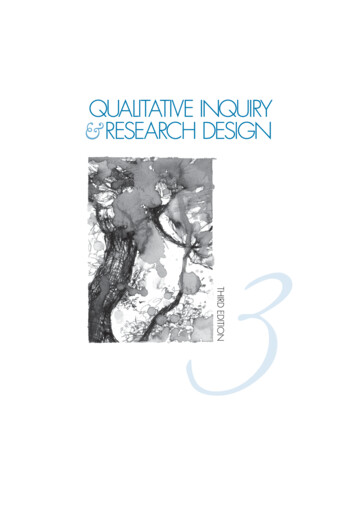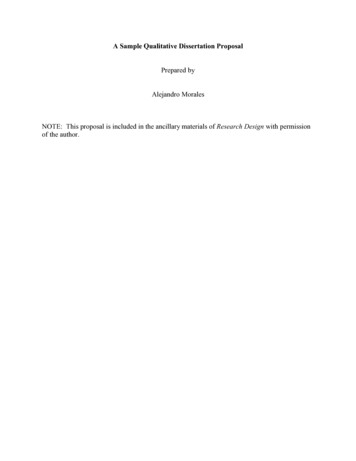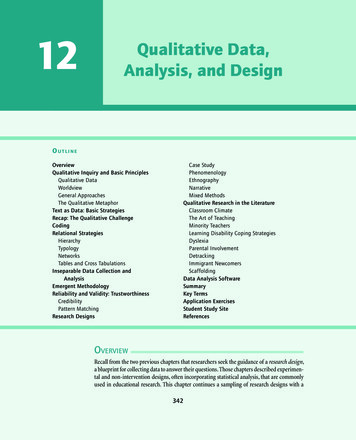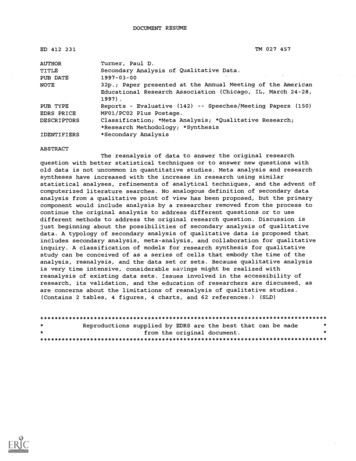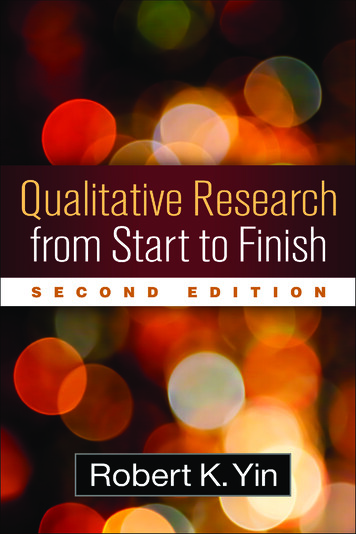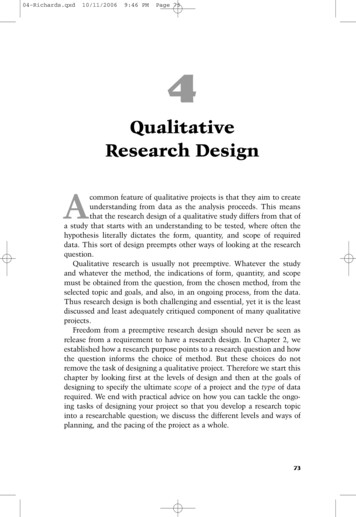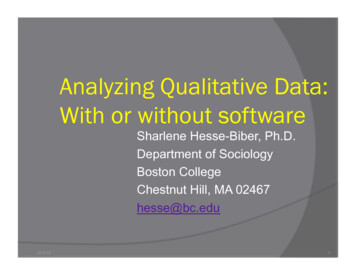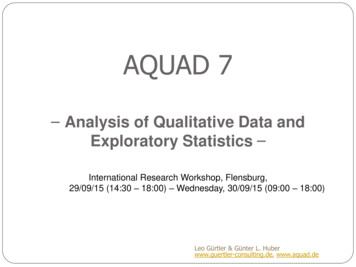
Transcription
AQUAD 7– Analysis of Qualitative Data andExploratory Statistics –International Research Workshop, Flensburg,Tuesday, 29/09/15 (14:30 – 18:00) – Wednesday, 30/09/15 (09:00 – 18:00)Leo Gürtler & Günter L. Huberwww.guertler-consulting.de, www.aquad.de
Data analysis is always some kind of data reduction the goal is to tell great stories based onminimal informationat best: explain the pastforecast the futureoffer intervention in the here-and-now to create abetter futureThis has nothing to do with a possible differencebetween QUAL and QUAN
Overview Quantitative Content AnalysisCode paradigm Exploratory Data Analysis (EDA) with statisticsSequential analysisBoolean MinimizationIn general: from the obvious/ manifest to thelatent level of data
Reconstruction ParadigmCoding ParadigmAnalysis of NonNumerical DataSequence AnalysisContent AnalysisPreparingSegmentsLatent ContentManifest tories(Versions)OverviewTestingHypothesesOpen CodingCountingKeywordsHypothesisbased CodingListing theResultsApplying aCategorySystemMixedMethods
"Text" as non-numerical data If we talk of „text“ here in this workshop, we apply avery broad understanding of what is a „text“.As a reference: Oevermann et al. (1979, p. 378)refer here to „protocols of real, symbolic mediatedsocial actions or interactions, may they be availablein a written form, audio, visual or combined, andbased on different media or archived in any otherfixed form".(translated by the authors from the original German)
Research questionsWhat typical research questions are knownin your field of interest wiht the goal toreconstruct meaning and sense directlyfrom the data?
Reconstruction ParadigmCoding ParadigmAnalysis of NonNumerical DataSequence AnalysisContent AnalysisPreparingSegmentsLatent ContentManifest pothesesOrderingStories(Versions)Content AnalysisOpen CodingCountingKeywordsHypothesisbased CodingListing theResultsApplying aCategorySystemMixedMethods
Content analysis In the social sciences, content analysis can berealized as a quantitative based or a qualitativebased method.In 1952, Kracauer as well as Berelson publishedtheir trend-setting articles.
Content analysis – actually:TEXT reduction writing, search & replace, find something, create tables,
Content analysis – The code paradigmQualitative content analysis reduces a huge amount ofdata (text, audio, video, pictures) by identifying areasthat represent a special interpretation and meaning.A “code” is a shortage of this meaning and it is directlyrelated to the part for which a meaning has to be found.Codes are representatives of units of meaning.It is a process of building and/ or developing a codesystem.Different codes summed up together can result in a new(meta-)code – the same is true for complex sequencesof codes - „chunking“.
Reconstruction ParadigmCoding ParadigmAnalysis of NonNumerical DataSequence AnalysisContent AnalysisPreparingSegmentsLatent ContentManifest tories(Versions)TestingHypothesesOpen CodingCountingKeywordsHypothesisbased CodingListing theResultsApplying aCategorySystemMixedMethodsAnalysis of Manifest Content the obvious
Quantitative content analysis Extrema: Analysis of mere formal characteristics asa source of insightPiantadosi ST, Tily H, & Gibson E (2011). From theCover: Word lengths are optimized for efficientcommunication. Proceedings of the National Academy ofSciences of the United States of America, 108 (9), 35269 PMID: 21278332
Quantitative content analysis After Berelson, the goal of quantitative analysis oftexts is to find out the manifest content ofcommunication – in a systematic, objective, andquantative way.E.g. frequency approach: count key words (later:count complex sequences of words/ phrases)What are keywords? They point out the opposite ofthe coding process: take a category and create orfind a keyword that represents only this specificcategory. The categories must be definite/ disjunct.
Application of quantitative contentanalysis What are typical research questions that can beasked in this specific area of research? In which ways are these questions different fromthe typical, already mentioned researchquestions of the qualitative kind?
Exploratory data analysis pt1 How does it look like if we visualize quantitativecontent analyses?What can we expect – and what not?Exploratory actually means exploratory, we donot talk of deduction, explanation, etc. in thescientific way of understanding. It is nothypothesis testing, it is not the experimentaldesign.
The functions of EDA(from a seminar announcement) "The exploratory data analysis is a set of strategiesfor the analysis of data with the goal to permit thatthe data speak and we find patterns in the data. In many situations an exploratory data analysis mayprecede a situation of formal inference, while inother situations the exploratory analysis maysuggest questions and conclusions, which could beconfirmed with an additional study. Accordingly theexploratory data analysis may serve as a useful toolfor the generation of hypothesis, conjectures andquestions regarding the phenomena the data camefrom."
Researchexample:Bush vs. Kerry
Researchexample:Wordfrequencies inquestionnaires(school)groups: male/female es word production: non-similar word
Researchexample:Wordfrequencies inquestionnaires(school)groups: words sex school typequestionnaires word production: non-similar word
Researchexample:Wordfrequencies inquestionnaires(school)scatterplot - exploration ofcorrelative relationshipsquestionnaires word production
Reconstruction ParadigmCoding ParadigmAnalysis of NonNumerical DataSequence AnalysisContent AnalysisPreparingSegmentsLatent ContentManifest tories(Versions)TestingHypothesesOpen CodingCountingKeywordsHypothesisbased CodingListing theResultsApplying aCategorySystemMixedMethodsAnalysis of Latent Content
Qualitative content analysis Reconstruct the latent level of meaningRorschach Test
What are latent contents? and what are typical research questionsrelated to the reconstruction of latent contentand hidden meaning? which questions are not related to latentcontent?
Qualitative content analysis Qualitative content analysis in accordance to Kracauertargets to find out the hidden meaning, ie. the latent meaning,of dataDifferent approaches – same instruments: interpretation (buthere: thinking and logical reasoning, no number-crunching)Problem: How to ensure that the process of reconstruction ofhidden meaning is realized in a systematic, scientific, andserious way? This leads to the question of objectivity or intersubjectivity and/ or ist appropriateness, necessity, etc.In short – criteria of scientific working
How to find categorial codesDeductionFrom the general to the specificGenerate hypotheses bx deductionand test themAbductionAbductionfinding rules – from caseto caseInductionFrom the specific to the general byfinding general rules – empirical basedtheory buildingtaken from Gürtler (2005).
How to find categorial codes
How to find categorial codes Application of available category systemsHypothesis-based categorizationDevelopment of categories by empirical-based"theory-building"
Example: Category system by Flanders Already in 1970, Ned Flanders made the usage ofobservation protocols popular in the research ofteaching. His "Flanders Interaction Analysis Categories"(FIAC) consists of 10 behavioral categories to measurethe interaction of teachers and students. Trainedobservers used the protocol and drew a picture of thevarious processes that took place in class.Within these observations, researchers investigated thetypical patterns of social interactions.Flanders‘ work encouraged many scientists to developtheir own specific context-based observation protocols.see also: aching-METHODS-STUDYING.html#ixzz28n2LQ6HW
Hypothesis based coding The research questions lead to hypotheses that give adirection while searching for units of meaning within thedata. Along with these hypotheses categories andcoding rules are worked out.However, the decisions about specific categories aremade at the time of creating the research design andfrequently even before data collection.The leading questions of an interview are based ondeductive reasoning based on these hypotheses.As a result not every bit of the data fits to this deductivebased categorical system. Then, inductive reasoning tobuild new categories is required to prevent a loss ofimportant information.
Glaser & Strauss (1967; 1979): Discovery ofa "Grounded Theory" The term „discovery“ emphasizes the essentialdifference to methodological approaches that arededicated to confirm existent theories. "GroundedTheories" are built during and caused by the process ofcontent analysis & coding.This process starts with an observed phenomenonwithin the data which the researcher tries to understandand to explain – it does not start with a theory with thegoal of falsification (Strauss & Corbin, 1990).The approach requires a maximum of interpretive skills.Whereas hypothesis based coding can rely on a generalorientation in the data, the discovery of a theory is facedby the challenge to get a grip about the story hidden inthe data themselves.
Different kinds of Coding (Strauss & Corbin, 1990)Open coding: Search for “emerging” categoriesAxial coding: Work according to general ideas andhypothesesThematic coding: Abstraction of the guiding themein the dataThis will be contrasted (later) by Sequential analysis
After coding – what now? Summarize codes to meta-codes ( ie. codes on abroader and more abstract/ hierarchical level)Matrix analysis (Miles & Huberman), i.e. countcodes and create frequency tables (later: visualizeand analyze via EDA sensu Tukey)Search for structures within codes: Formulate hypotheses about relationships within the codesTest hypotheses on the data (text) and add the (positive)results as new and unique codesSearch for complex sequential code sequences, andperform another matrix analysis sensu Miles & Huberman
Research example Research study from Spain about leadership inschoolBase: n 31 interviews ( cases)Coding of the interviews with AQUAD 7Topics (Meta-Codes): Charisma, Emotion,Anticipation, Professionalism, Participation, Culture,Further Training, AdministrationGraphical visualization of data to explore the topicsand possible relationships between (meta-)codesand between cases
Questions related to the researchexample How can we – hypothetically – answer the researchexample of leadership in the Spanish schoolsystem? Try to imagine . No reality necessarilyinvolved. OR – what do you think – which topics aredefinitely not part of the answer? What do youexpect?What about the latent meaning – what at all is latentin this context?
Conversion designs andexploratory statistics Conversion design 1.0: In most social studiessocio-demographic data include metric data, forinstance, age or years of professional experienceof respondents of a questionnaire. These dataare regularly grouped and converted into nominaldata, which structure further analyses. Conversion design 2.0: A typical example is themethod of quantitative content analysis, which isbased on critical keywords (qualitative phase).Their frequencies are then (quantitative phase)analyzed statistically.
Conversion design 3.0 combines a full qualitative analysis withexploratory data analysis usually in sequentialorder. The first strand represents a fully markedqualitative study with interpretative results basedon a well-founded and justified coding system.The conversion of critical codes in frequency dataallows statistical analyses that help to revealadditional structures or patterns of meaning withinthe data.
EDA in conversion designs 3.0 EDA assists to explore the data with more depthand to see implicit patterns or data structures,which are not necessarily visible by means ofexclusive qualitative, i.e. interpretive analysis. EDA invites to play with the available data andreveals expected or unexpected data patterns –or the absence of such patterns. “Far better an approximate answer to the rightquestion, which is often vague, than the exactanswer to the wrong question, which can alwaysbe made precise.” (Tukey, 1962:13)
Analysis of pictures and graphs same procedure similar results
Now to something completely different – squentialanalysis Craft and Art
Reconstruction ParadigmCoding ParadigmAnalysis of NonNumerical DataSequence AnalysisContent AnalysisPreparingSegmentsLatent ContentManifest pothesesOrderingStories(Versions)Sequence AnalysisOpen CodingCountingKeywordsHypothesisbased CodingListing theResultsApplying aCategorySystemMixedMethods
Sequential analysis or „structuralhermeneutics“ (German socioloy)[ ], as long as I live27.06.2012 (AM)
or any other well-known citationI have a dream 28.08.1963 (MLK)
What can you derive from a singlesentence? Or even a few words?Is there already some meaninginvolved?Or is it meaningless?
Strategy Sequential analysis is not very known in non-Germanspeaking countries. It starts not by gaining an overviewof the material, separate it into small bits of information,and apply existent hypotheses on them, etc.Instead – we start with a single part of the data andproceed step by step in order ie. in strict sequence!Along the way, we make notes of every thinkable andrelevant meaning related to the part that is discussed atthe moment.We create hypotheses about the future of the text – andtest these hypotheses on the text while using the nextsegment of the data.
Reconstruction of structures
Objektive structures of meaning Goal of sequential analysis according toOevermann et al. (1979) is to use texts as protocols“of real, symbolic mediated social actions andinteractions” (p. 378). The goal is to reconstruct thehidden latent meaning based on objective data andmethods and contrast it to the manifest meaning:"Interaktionstexte konstituieren aufgrundrekonstruierbarer Regeln objektiveBedeutungsstrukturen und diese objektivenBedeutungsstrukturen stellen die latentenSinnstrukturen der Interaktion selbst dar." [kursiv imOriginal]
.which can be translated to: A text is always based on rules which can bereconstructed.A text constitutes itself because of these rules withpatterns of objective meaning.These patterns of objective meaning themselvesare the latent structures of meaning of the text itself. it is a little bit like Münchhausen orbootstrapping. You reconstruct the hidden meaningdirectly from where the meaning takes place.
Sequential analysis Sequential analysis starts with a unique and single partof the text, e.g. the introduction. For each segment allthinkable and hypothetical meanings are created. Weask „How can we interpret this part? What story does ittell us – and how does the story goes on?“A segment of the text can be anything: full sentences,parts of a sentence, or even words, phrases, a specificamount of words, etc. There is no fixed rule. Thesegments will be defined before the analysis.The generation of hypotheses is a strictly hypothesisbased sequential process: the text will be interpretedstep by step without neglecting anything nor relying onfuture, not-yet-seen data. This represents the scientificprinciples: hypotheses building and testing.
(preliminary) Case structures If we work in this order, step by step many hypothesesare formulated and almost all are falsified. But is leftbecomes thicker and richer in ist meaning and its scope.At some point we realize that the „structure“ repeatsitself – it does not seem that something new is gainedby working further. That is the point a preliminary casestructure can be formulated. It answers the followingquestion: „What is the case?“Then – the preliminary case structure has to bechallenged at other critical parts of the text to proof itsstability and substance.
Main menu – AQUAD Seven
Create data segementsDefine units of analysis
Generate hypotheses .risk. and failure
Generate hypotheses (Rule: make notes of everything)
Make notes of everything that can beimagined – an example:Segment 1:"Hallo, hallo!"?What does this mean?Tell a story!
An exampleSegment 1: "Hallo, hallo!"Someone tries to call attention to someone.Someone tries to call attention to someone who lostsomething.Someone opens a door and greets a visitor.Someone greets someone else while walking fast along.Someone expresses anger.Someone tries to call unspecific attention.
Next step: categorize stories accordingto „interpretation“ (German: „Lesart“) Three types of interpretation of the segment "Hallo,hallo": (1) call attention(2) greetings(3) express anger
Structural analysis:Latent structure of meaning The latent structure of meaning can bereconstructed by applying the rules that everyinteraction is bound to. Oevermann et al. (1979,p.370) name „syntactical rules, pragmatical rules,rules of sequencing of interactions, rules how todistribute contributions, etc.". These relationshipscan be made accessible from the text itself. Theinteracting groups or people not necessarily have tobe aware of the way the text is emerges or even beaware of the underlying latent structure.In short: the case always reveals itself – you havenothing to do except performing proper analysis.
Step-wise procedure – sequential! Oevermann et al. (1979, p.354) state that this approachis based on simple and almost trivial assumptions thatare used for reasoning.But – we have to stick to them very thoroughly.However, these assumptions lead to very strictmethodologial consequences. It must be noted that noinfos of later incidents must be used to interpretprevious incidents (Oevermann et al., 1979, p.414).Or – as Wernet (2009, p.28) emphasizes: “We do notsearch along the text to find something usable, instead,we follow the protocol/ text step by step along its naturaldevelopment."
Five rules to generate hypotheses(1) ignore the context (Kontextfreiheit) (2) strict formal interpretation (Wörtlichkeit) (3) sequence order (Sequentialität) (4) everything is equally important(Extensivität) (5) economy (Sparsamkeit)
(1) Ignore the context (German:Kontextfreiheit) Of course we must consider the context of the origins ofthe text while interpreting. But only afterwards at a stagewhen we have already reconstructed the meaningunderlying a text segment.At first, we invent stories in which the text segment inquestion makes sense. We imagine how it can be so itdoes make sense – and for that we have to broaden ourview far beyond the „real“ context. Otherwise we sticktoo fast to selfullfilling prophecies.Instead, we have to explore the whole area of possiblemeaning – to contrast with the real text and its naturalcourse.
(2) Strict formal interpretation (German:Wörtlichkeit)If we interpret anything, only the text itself – as being a manifestationof reality – is important. Only there we can perform analysis as wellas hypothesis testing. We do not imagine and test against somethingthat is not part of the text ie. which is not real in its nature. The textitself is operationalized as some part of reality and that‘s the„objective“ part. We use only objective information accessible by thetext itself.Consequences: (1) This working procedure requires the text in its original form withoutchanging it in any way – e.g. a true-to-audio transcript is valid, but noparaphrases are allowed! (2) Interpretation is done rather finical. It is not allowed to ignore hazyor inappropriate looking details as we do in everyday life. Wernetstates that we „have to weigh one's words” very thoroughly whichwould sound very pedantic in normal life. Rule: We interpret what is really part of the text.
(3) Sequential order (German: Sequentialität) This principle represents the core of the analysis. Wework step by step along the natural order of the textwithout doing this jump or that one. The procedure islogic in its nature and stepwise. This means we performa constant dance between „generating hypotheses“ and„testing hypotheses“ directly on the text. The first place to start the analysis is not fixed. It can bethe first sentence, but this is not essential. But as soonas one starts the work, the sequential order is essential.Everything which follows later in the text is ignored aslong as it is not the time to analyze this segment, too.
(4) Everything is equal important (German:Extensivität) Everything is equal important points to a balancedprinciple. Its meaning is to avoid subjective, impulsive,and arbitrary interpretations. What seems to be anunimportant detail is equal important to everything else.There is no reason to focus on “obviously” importantparts of the text or ignore other information. Importanceor non-importance is a product of subjectivity, not ofscience per se. If we handle each text segment andevery detail the same way, this leads to a situationwhere our imagination about possible meanings andlatent structures covers the whole spectrum of possibleoutcomes. Rule: Do not neglect anything, do not give importance toyour own subjectivity if you ignore the data as aconsequence.
Economy.Occam‘s razor
(5) Economy (German: Sparsamkeit) This principle requires, that we expect everything to benormal while generating hypotheses and possiblemeanings. We include only those hypotheses which canbe falsified by the text itself.This narrows down the possible hypothesis space(„story telling“) to those variants that are in line with thetext.We do not create science fiction here nor does we allowesoteric stories or pathologies not based in the text.Rule: Everything is handled as normal unless the textproofs that it is not.
Testing hypotheses
Part 2 – critical testing ofhypotheses On the methodological level, we follow the principle offalsification as laid down by Popper (1934). We drop ahypothesis after falsification and we maintain it unless itis falsified. In this sense there is no verification ofhypotheses. Proofing a hypothesis wrong just meansthat the hypothesis in question is not in line with the text.In this phase we do not work in sequence orderanymore. Instead, we search for those parts of the textthat have the biggest impact to bring down(“falsification”) the preliminary case-structure ( hypothesis construct).We explicitly search for counter-evidence to falsify ourpreliminary case-structure.
General attitude while interpretating The process of sequence analysis follows thetext (and all incidents) in its natural order as it isthe case.Wernet (2009, p.27) emphasizes the importanceof our “interpretative attitude” which means wehave to take the text really serious. It is not amarket of information we can use to put in somemeaning that suits us. We should not make useof meanings in an inflationary manner.
Objektive vs. subjective meaning The objective structure of meaning or the latentpattern of significance has to be analyzed beforewe consider the subjective perspective of those whoare involved – and that can be a different source ofdata of course.Oevermann et al. (1979, p.380) are very precisewhen they use the term “objective meaning” whichmeans an interpretation is based on objective data /social structure – not on subjective data. Thesedata are the pre-requisites of subjective intentions.
Cut-off of sequential analysis – whendoes it end?
When does a sequential analysis end?There are two phases: (1) We analyze in sequence order unless the underlyingcase structure is reproduced once – but fully(Oevermann, 1996). The assumption is that thisstructure recreates itself continuously. Therefor there isno need to analyze all data, but rather analyze somedata but very thoroughly. This ensures not to neglectanything. In sum, this leads to a preliminary casestructure. (2) We search for counter-evidence to falsify ourpreliminary case structure. If it proofs to be stable, this isour result. Otherwise, we have to start again (fromscratch).
Research example Application letter from detox (stationary psychiatry,fax) sent to a drug-addict center
Research exampleApplication for an interview[ ]anonymous client
Reflections about sequence analysis What are the differences between codingparadigm (ie. content analysis) and sequentialanalysisAre there any similarities between them?How does it work in research practice?Is it possible to combine these approaches?
Search and find configurations Base: Boolean minimization (pure logic)Goal: Find code configurations for subgroups/ casesApplication: type building, meta-analysis, find minimalsets of codes (categories) that are sufficient for anoutcome to become true or falseCriteria: positive or negative (both required)There are no objective criteria. This is pure exploratorydata analysis, but based on logic, not on statistics. Itdoes not handle causality in reality.Introduced by C.Ragin (1987) into the social sciences
Research example Booleanminimization Research study (Spain, interviews with teachers)(Marcelo, 1991). Starting point was the observation thatyoung teachers talked a lot about disciplinary problems,but not all mentioned this topic. Research question: Critical differences between teachers who mentiondisciplinary problems (yes/ no)
Units of analysis Important topics based on interview analysis (codes): A teachers themselvesB teacher-student relationshipC teaching methodD disciplinary problems ( criterium)E student’s motivationF general class climateQuestions: Which code configurations are typical, if disciplinaryproblems TRUE?Which cases are covered by these configurations?
Method and truth values The method works absolutely logical based on Booleanminimization – there is no number-crunching.All configurations (TRUE/ FALSE) will be compared witheach other. There is not shortcut.Procedure: If two configurations differ only on onecondition but lead to the same output (TRUE/ FALSE),then this one condition can be dropped, because it is notrelevant to reach the output criterion.This reduces all configurations till no further reduction ofconfigurations is possible.
Results Marcelo (1991) found the following solutions: D ABC ACEF abcefThis means there are three different groups of teachers(beginners) and each group encountered differentdisciplinary problems. The exact interpretation of thesetypes is therefor important for further procedures likesupervision, peer-coaching, teacher education, etc. Itmust be put back to the practical level.The method shows not only the configurations, but alsothe cases related to the results on the level of originaldata material.
Results D ABC ACEF abcef with the categories: A teachers themselvesB teacher-student relationshipC teaching methodD disciplinary problemsE student’s motivationF general class climateQuestion: What does this means on a concrete level?
Interpretation und application Boolean minimization requires: The procedure gives the following output: data material is already codedin case of meta-analysis - data of research studieschoose a criterion (true/ false)Which sets of minimal configurations related to the criterionin question (true/ false) can be identified – and which casesare covered by these minimal configurations?Therefor we can perform type building or doresearch on complex influencesThus, the method is fit to be used for theory buildingas well as post-hoc meta-analysis.
Reprise – qualitative approaches What important differences and similarities can you findfor the following research approaches? Quantitative Content AnalysisQualitative Content AnalysisSequential AnalysisBoolean MinimizationExploratory Data Analysis (i.e. graphs of frequency tables) How can you apply it in your own research? Whatquestions follow – what makes sense, what doesnot make sense? Which methods do you like and why?
References Berelson, B. (1952). Content analysis in communication research. Glencoe, Ill.: TheFree Press.Huber, G. L. & Gürtler, L. (2012). Manual zur Software AQUAD 7(Erstveröffentlichung 2003, Tübingen: Ingeborg Huber Verlag). Tübingen:Softwarevertrieb Günter Huber. Online verfügbar: www.aquad.deKracauer, S. (1952). The challenge of qualitative content analysis. Public OpinionQuarterly, 16, 631-642.Oevermann, U. (1996). Konzeptualisierung von Anwendungsmöglichkeiten undpraktischen Arbeitsfeldern der objektiven Hermeneutik. Frankfurt am Main: GoetheUniversität.Oevermann, U., Allert, T., Konau, E., & Krambeck, J. (1979). Die Methodologie einer"objektiven Hermeneutik" und ihre allgemeine forschungslogische Bedeutung in denSozialwissenschaften. In H.-G. Soeffner (Ed.), Interpretative Verfahren in den Sozialund Textwisssenschaften [Interpretative procedures in the social and text sciences].Stuttgart: Metzler.Ragin, C. (1987). The Comparative Method: Moving Beyond Qualitative andQuantitative Strategies. University of California Press.Wernet, A. (2009). Einführung in die Interpretationstechnik der ObjektivenHermeneutik (3. Aufl.). Wiesbaden: VS Verlag für Sozialwissenschaften.
?QuestionsTheoryPractice
"The exploratory data analysis is a set of strategies for the analysis of data with the goal to permit that the data speak and we find patterns in the data. In many situations an exploratory data analysis may precede a situation of formal inference, while in other

